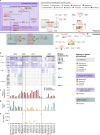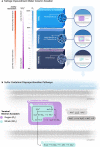O2 partitioning of sulfur oxidizing bacteria drives acidity and thiosulfate distributions in mining waters
- PMID: 37037821
- PMCID: PMC10086054
- DOI: 10.1038/s41467-023-37426-8
O2 partitioning of sulfur oxidizing bacteria drives acidity and thiosulfate distributions in mining waters
Abstract
The acidification of water in mining areas is a global environmental issue primarily catalyzed by sulfur-oxidizing bacteria (SOB). Little is known about microbial sulfur cycling in circumneutral pH mine tailing impoundment waters. Here we investigate biological sulfur oxidation over four years in a mine tailings impoundment water cap, integrating aqueous sulfur geochemistry, genome-resolved metagenomics and metatranscriptomics. The microbial community is consistently dominated by neutrophilic, chemolithoautotrophic SOB (relative abundances of ~76% in 2015, ~55% in 2016/2017 and ~60% in 2018). Results reveal two SOB strategies alternately dominate across the four years, influencing acid generation and sulfur speciation. Under oxic conditions, novel Halothiobacillus drive lower pH conditions (as low as 4.3) and lower [S2O32-] via the complete Sox pathway coupled to O2. Under anoxic conditions, Thiobacillus spp. dominate in activity, via the incomplete Sox and rDSR pathways coupled to NO3-, resulting in higher [S2O32-] and no net significant acidity generation. This study provides genomic evidence explaining acidity generation and thiosulfate accumulation patterns in a circumneutral mine tailing impoundment and has significant environmental applications in preventing the discharge of sulfur compounds that can impact downstream environments. These insights illuminate opportunities for in situ biotreatment of reduced sulfur compounds and prediction of acidification events using gene-based monitoring and in situ RNA detection.
© 2023. The Author(s).
Conflict of interest statement
The authors declare no competing interests.
Figures





Similar articles
-
pH and thiosulfate dependent microbial sulfur oxidation strategies across diverse environments.Front Microbiol. 2024 Jul 19;15:1426584. doi: 10.3389/fmicb.2024.1426584. eCollection 2024. Front Microbiol. 2024. PMID: 39101034 Free PMC article.
-
Microbial sulfur cycling determinants and implications for environmental impacts.Chemosphere. 2025 Mar;372:144084. doi: 10.1016/j.chemosphere.2025.144084. Epub 2025 Jan 14. Chemosphere. 2025. PMID: 39798717
-
Thiosulfate oxidation by Thiomicrospira thermophila: metabolic flexibility in response to ambient geochemistry.Environ Microbiol. 2016 Sep;18(9):3057-72. doi: 10.1111/1462-2920.13232. Epub 2016 Mar 21. Environ Microbiol. 2016. PMID: 26914243 Free PMC article.
-
Roles, mechanism of action, and potential applications of sulfur-oxidizing bacteria for environmental bioremediation.Sci Total Environ. 2022 Dec 15;852:158203. doi: 10.1016/j.scitotenv.2022.158203. Epub 2022 Aug 28. Sci Total Environ. 2022. PMID: 36044953 Review.
-
Oxidative metabolism of inorganic sulfur compounds by bacteria.Antonie Van Leeuwenhoek. 1997 Feb;71(1-2):95-107. doi: 10.1023/a:1000135707181. Antonie Van Leeuwenhoek. 1997. PMID: 9049021 Review.
Cited by
-
Metabolic redundancy and specialisation of novel sulfide-oxidizing Sulfurimonas and Sulfurovum along the brine-seawater interface of the Kebrit Deep.Environ Microbiome. 2025 Feb 5;20(1):19. doi: 10.1186/s40793-025-00669-7. Environ Microbiome. 2025. PMID: 39910644 Free PMC article.
-
Microbial community structural and functional differentiation in capped thickened oil sands tailings planted with native boreal species.Front Microbiol. 2023 Jul 3;14:1168653. doi: 10.3389/fmicb.2023.1168653. eCollection 2023. Front Microbiol. 2023. PMID: 37465026 Free PMC article.
-
pH and thiosulfate dependent microbial sulfur oxidation strategies across diverse environments.Front Microbiol. 2024 Jul 19;15:1426584. doi: 10.3389/fmicb.2024.1426584. eCollection 2024. Front Microbiol. 2024. PMID: 39101034 Free PMC article.
-
Biogeography and ecological functions of underestimated CPR and DPANN in acid mine drainage sediments.mBio. 2025 Jun 11;16(6):e0070525. doi: 10.1128/mbio.00705-25. Epub 2025 Apr 29. mBio. 2025. PMID: 40298441 Free PMC article.
-
Influences of fluctuating nutrient loadings on nitrate-reducing microorganisms in rivers.ISME Commun. 2024 Dec 24;5(1):ycae168. doi: 10.1093/ismeco/ycae168. eCollection 2025 Jan. ISME Commun. 2024. PMID: 39839890 Free PMC article.
References
-
- Lindsay MBJ, et al. Geochemical and mineralogical aspects of sulfide mine tailings. Appl. Geochem. 2015;57:157–177. doi: 10.1016/j.apgeochem.2015.01.009. - DOI
-
- Miranda-Trevino JC, Pappoe M, Hawboldt K, Bottaro C. The importance of thiosalts speciation: review of analytical methods, kinetics, and treatment. Crit. Rev. Environ. Sci. Technol. 2013;43:2013–2070. doi: 10.1080/10643389.2012.672047. - DOI
Publication types
MeSH terms
Substances
LinkOut - more resources
Full Text Sources
Miscellaneous

